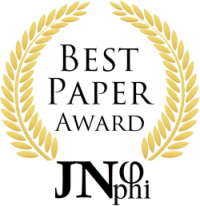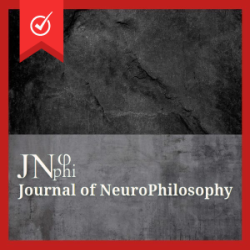Submissions
Submission Preparation Checklist
As part of the submission process, authors are required to check off their submission's compliance with all of the following items, and submissions may be returned to authors that do not adhere to these guidelines.- The submission file is in OpenOffice, Microsoft Word .docx, .doc, or .rtf document file format.
-
Please use the article template here when preparing your article
Download the JNphi Article Template - Provide the given name(s) and family name(s) of each author. The order of authors should match the order in the online submission system.
- A detailed biography of each author should be available in the online system and in the submitted article, as stated in the Information for the Author section/article template.
Opinion and Perspectives
Copyright Notice
Free to read, free to publish! Authors are not charged a fee for submission or publication. All articles published within JNphi – archive, current, and future – will be immediately accessible without restriction, maximizing the impact of the high-quality research we publish.
Open Access ensures no barriers to access, facilitating openness, transparency, dissemination, and reproducibility of impactful academic research. Articles in the JNphi will be published under a Creative Commons Attribution license (CC BY), which permits unrestricted reuse, distribution and reproduction in any medium provided the original is properly cited.
Open Access authors retain the copyrights of their papers, and all open access articles are distributed under the terms of the Creative Commons Attribution License, CC BY (or the Creative Commons Attribution-NonCommercial License CC BY-NC), which allows users to (noncommercially) copy, use, distribute, transmit and display the work publicly and to make and distribute derivative works, in any digital medium for any responsible purpose, subject to proper attribution of authorship.
The use of general descriptive names, trade names, trademarks, and so forth in this publication, even if not specifically identified, does not imply that these names are not protected by the relevant laws and regulations.
While the advice and information in this journal are believed to be true and accurate on the date of its going to press, neither the authors, the editors, nor the publisher can accept any legal responsibility for any errors or omissions that may be made. The publisher makes no warranty, express or implied, with respect to the material contained herein.
Privacy Statement
The names and email addresses entered in this journal web site will be used exclusively for the stated purposes of this journal and will not be made available for any other purpose or to any other party. We will only use the personal data gathered over this website as set out in this policy. We have implemented appropriate safeguards to secure your personal data and retain your personal data only as long as necessary. When you visit our website for informational reasons, i.e., examples might include:
φ your IP address;
φ your device type, name and IDs;
φ the date and time of your requests;
φ the content of your requests;
φ information on your browser version;
φ your screen resolution;
φ information on your operating system, including language settings.
We use such information only to assist us in providing an effective service (e.g. to adapt our website to the needs of your device or to allow you to log in to our website), and to collect broad demographic information for anonymised, aggregated use. We strive to keep our processing activities with respect to your personal data as limited as possible. In the absence of specific retention periods set out in this policy, your personal data will be retained only for as long as we need it to fulfil the purpose for which we have collected it and, if applicable, as long as required by statutory retention requirements.
If you are identified by IP or equivalent method as belonging to a customer organisation such as university or a company then we will also collect the identity of that organisation and use it to create usage reports which show the organisation how much of the content we publish is being read by their students, members or employees. This information does not contain anything related to a personal login unless (a) you are a nominated administrator for that organisation or (b) your organisation specifically requires it as a part of a usage-based access contract. If you need to create a personal login with us then we will store and process the following:
φ Information (your name, user name and email address) that is provided by registration;
φ Information in connection with an account sign-in facility (e.g. log-in and password details);
φ Communications sent by you (e.g. via e-mail or website communication forms).
The information that is necessary for the performance of the service is labelled accordingly. All further information is provided voluntarily. With your email address you can subscribe to our newsletters that provide you with the latest news about our products and services if you consent to receiving such newsletters. You can unsubscribe from this service by opting out via the link provided in each newsletter.
Our Submission and Peer Review System offers the services of peer review, content preparation and proofing, publication and dissemination of research. In order to use the aforementioned services you have to set up an initial account. With regard to the registration of an account and its subsequent use, we process the following information;
φ Information that is provided by registration such as your name, user name and email address.
φ Information in connection with an account sign-in facility, e.g. log-in and password details;
φ Communications sent by you, e.g. via e-mail or website communication forms.
φ Content files and covering letters provided by you
φ Grants, funding, membership, institution, society, committee registration
φ Information received from societies we work with, e.g. address, name, email address
Google Analytics
We use Google Analytics, a web analytics service provided by Google. The cookie set by Google Analytics on your device causes your web browser to transmit corresponding information to Google each time our website is called up. For example, Google Analytics collects data about the website from which a data subject has accessed a website (so-called referrer URL), which subpages of the website have been accessed or how often and for how long a subpage has been viewed. On our behalf Google will use the information generated by the cookie for the purpose of evaluating your use of the website, compiling reports on website activity and providing other services relating to website activity and internet activity in connection with the use of the website and according to your consent preferences. The processing affects the following data categories:
φ IP addresses
φ Online identifiers (including cookie identifiers)
φ Device identifiers
φ Technical characteristics of users (e.g., browser type, device type, operating system)
φ Measurement of user behavior (e.g., views of individual pages, session duration)
φ Use of individual website functionalities (e.g. timetable, search queries, downloads)
φ Referral URL
We use the addition "_gat._anonymizeIp" for web analysis via Google Analytics. By means of this add-on, your IP address is shortened and anonymized by Google before transmission to the USA if our website is accessed from a member state of the European Union or the European Economic Area. Only in exceptional cases will the full IP address be transmitted to a Google server in the USA and shortened there.
Your personal data will be anonymized by Google 14 months after your last activity, unless there is a legal obligation to retain it. You may refuse the use of cookies by selecting the appropriate settings on your browser or by amending your preferences. In addition to that you may prevent the collection of the information generated by the cookie about your use of the website (including you IP address) and the processing of this data by Google if you download and install the browser plug-in available at the following link: http://tools.google.com/dlpage/gaoptout. You can access the Google Analytics privacy policy here.In addition to the above, we use historic pseudonymised Google Analytics data to recommend content to you based on your website activity, particularly suggesting articles that may be of interest.
We use the twitter-button. The button is provided by Twitter Inc., 795 Folsom St., Suite 600, San Francisco, CA 94107, USA. (“Twitter”) The buttons are marked using the text “Twitter” or “Follow” and a stylized blue bird. The button enables the user to share an article or a website of this homepage on Twitter or to follow the provider on Twitter. If a user visits one of the websites using such a button, the user’s browser directly connects to Twitter’s servers. The Twitter-button and its content are loaded directly from Twitter’s servers and included in the website by the user’s browser. According to the provider’s knowledge, Twitter collects the user IP-address and the website’s URL when the button is loaded from Twitter’s servers. However, this data is only be used for loading and displaying the Twitter-button. Further information can be found in Twitter’s privacy statement under: https://twitter.com/privacy.
Definitions
Personal data: means any information relating to a natural person who can be identified, directly or indirectly, in particular by reference to an identifier such as a name, an identification number, location data, or an online identifier.
Processing: means any operation which is performed on personal data, such as collection, recording, organisation, structuring, storage, adaptation or any kind of disclosure or other use.
Ver.02.11.2024 φ

 PREPARATION OF ARTICLES
PREPARATION OF ARTICLES

